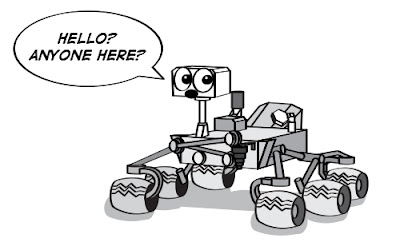This week, PVL Postdoc Christina Smith reflects on the youth outreach activity we completed in late may as part of our Ministry of Research, Innovation and Science Early Career Researcher Award. Both we and our guests had a great time and it's never too early to start thinking about next year! Image taken from: https://spaceplace.nasa.gov/mars-curiosity/en/ .
By Christina Smith
On May 27th, as per Brittney's blogpost, we at the Planetary Volatile Laboratory held an analog mission day for upper high school and undergraduate students. Missions like this, aimed primarily at education and outreach as opposed to technological proof-of-concepts, simultaneously give students a taste of what being part of a science operations team for a real-life rover mission is like as well as being fun for those involved. I had never participated in a rover analog mission, but when I was in high school in the UK, I had the chance to be part of a “Voyage to Mars," where we took the place of a crew traveling to Mars and I still remember it vividly (and fondly) to this day – especially the part where the oxygen tank sprung a leak and yours truly was in charge of life support for the mission... I hoped that the students coming to participate would enjoy their time on their first mission as much as I did on mine.
Every person who attended the day was assigned a role, including the members of the Planetary Volatile Laboratory who were helping out and organizing the day. I was assigned the role of “Head of Earth Exploration at the Canadian Space Agency” and it was my job to give them their first mission-based briefing of the day. I decided to launch wholeheartedly into the role and treat it as much like a formal briefing as I could. First, I took them through their science goals and objectives for the day. The overall mission goal was to “determine whether the Earth is habitable”, with objectives specifying measurements required to determine the environmental and surface habitability.
The next part of the briefing was based on their job to select a landing site for the mission. I described in very general terms how a real-life site selection process is carried out and the timelines involved. MSL, as an example, had a site-selection timeline of 5 years from the first workshop and 100 landing site shortlist in 2006, to the final selection of Gale Crater in 2011. We streamlined this process for the students in our analog mission day! They were provided with a number of maps, including elevation models, optical satellite images and infra-red data of the area I renamed “Eboracum Planitia” (Eboracum is the Roman word for the settlement in the UK that later became York - the area selected was York University Campus) to help them determine the best landing site given a set of landing constraints that the rover had.
After the landing site had been selected, they had to decide on the instruments that would go on the rover, taking into account the costs, weights, and sizes of each instrument and the mission budgets for each of those constraints. They also had to make sure that the combination of instruments they selected would allow them to complete their mission objectives satisfactorily. Then, it was time for their intro-to-operations workshop. This was where they learned more about the roles they had been assigned and what each one would involved. They also got to know the structure that their planning cycles would take, what order tasks would have to be done in, and what information would be uplinked to and downlinked from the rover.
With the mission-set up and training part of the day complete, it was time to begin the operations-segment of the day. The rover touched-down safe and sound within the landing area they specified and returned a panorama and a location detected from orbit – the only definitive location they would be given during their time in Mission Control. The students had a total of 3 planning “days” (sol) to meet their science goals and objectives. Each sol had a duration of 20 minutes, and they were given 30 minutes in total to plan each sol out. The team worked together throughout the three planning days to ensure that the rover performed important scientific measurements and drove towards a potential water source. Although it did have to go into safe-mode on one sol when it detected an abnormal feature underfoot (a pond – rovers don't like being driven into ponds...). The team successfully collected a variety of imagery, performed soil and water analyses and measured an assortment of environmental factors such as air temperature and oxygen abundance.
Overall, the team successfully achieved all their science goals and objectives. They determined that the Earth did appear to be habitable from their three days of scientific measurements and would back a future mission to explore the habitability and viability of human exploration of the region. They also appeared to enjoy their time in Mission Control, as did I, and I look forward to participating in another such mission in the future!

No comments:
Post a Comment